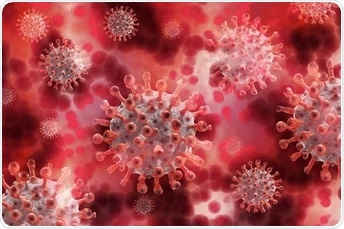According to a new study published in eLife, researchers have simulated the transition of the SARS-CoV-2 spike protein structure from the time it recognizes the host cell to its entry into the cell.

SARS-CoV-2. Image Credit: Public domain.
The study identified that a structure facilitated by sugar molecules on the spike protein can be vital for cell entry, and disrupting this structure could provide a strategy to halt virus transmission.
An important aspect of SARS-CoV-2’s lifecycle is its capability to bind to host cells and transmit its genetic material. This is facilitated by its spike protein, which is composed of three separate components—a transmembrane bundle that attaches the spike to the virus, and two S subunits (S1 and S2) on the exterior of the virus.
To affect a human cell, the S1 subunit attaches to a molecule on the surface of human cells named ACE2, and the S2 subunit separates and fuses the human and viral cell membranes.
Even though this mechanism is known, the precise order in which it happens is not yet discovered. Furthermore, deeper knowledge of the microsecond-scale and atomic-level movements of these protein structures could disclose possible targets for COVID-19 treatment.
Most of the current SARS-CoV-2 treatments and vaccines have focused on the ACE2 recognition step of virus invasion, but an alternative strategy is to target the structural change that allows the virus to fuse with the human host cell.”
José N. Onuchic, Study Co-Author and Harry C & Olga K Wiess Professor of Physics, Rice University
Onuchic is also the Co-Director of the Center for Theoretical Biological Physics.
“But probing these intermediate, transient structures experimentally is extremely difficult, and so we used a computer simulation sufficiently simplified to investigate this large system but that maintains sufficient physical details to capture the dynamics of the S2 subunit as it transitions between pre-fusion and post-fusion shapes,” added Onuchic.
The researchers were specifically interested in the function of sugar molecules on the spike protein known as glycans. The researchers carried out thousands of simulations employing an all-atom structure-based model to determine if the type, number, and position of glycans play a part in the membrane fusion stage of viral cell entry by facilitating these intermediate spike formations.
These models enable prediction of the trajectory of atoms over time considering the steric forces—such as how neighboring atoms impact the movement of others.
The simulations showed that glycans develop a “cage” that traps the “head” of the S2 subunit, making it pause in an intermediate form between when it separates from the S1 subunit and when the viral and cell membranes are combined. In the absence of the glycans, the S2 subunit spent a short span of time in this form.
The simulations also indicate that retaining the S2 head in a specific position helps the S2 subunit enlist human host cells and fuse with their membranes, by permitting the extension of small proteins called fusion peptides from the virus.
Undoubtedly, glycosylation of S2 substantially heightened the likelihood that a fusion peptide would extend to the host cell membrane, whereas in the absence of glycans, there is only a minimal possibility that this would take place.
Our simulations indicate that glycans can induce a pause during the spike protein transition. This provides a critical opportunity for the fusion peptides to capture the host cell.”
Paul C. Whitford, Study Co-Author and Associate Professor, Center for Theoretical Biological Physics, Northeastern University
Whitford is also an Associate Professor at the Department of Physics, Northeastern University, Boston, US.
“In the absence of glycans, the viral particle would likely fail to enter the host. Our study reveals how sugars can control infectivity, and it provides a foundation for experimentally investigating factors that influence the dynamics of this pervasive and deadly pathogen,” concluded Paul C. Whitford.
Source:
Journal reference:
Dodero-Rojas, E., et al. (2021) Sterically confined rearrangements of SARS-CoV-2 Spike protein control cell invasion. eLife. doi.org/10.7554/eLife.70362.